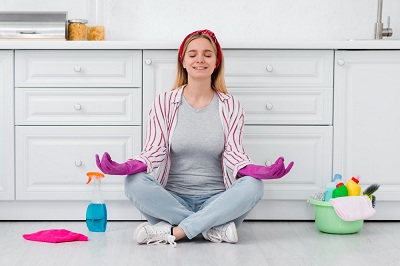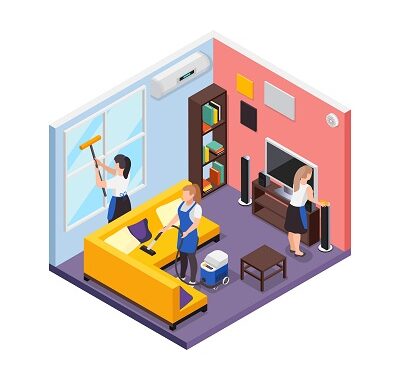Maintaining a spotless and healthy home is more than just an aesthetic choice; it’s a fundamental aspect of ensuring the well-being of everyone in the household. Clean spaces not only look good but also help in reducing the spread of germs, allergens, and other harmful agents. With a few strategic practices, you can achieve a pristine environment that supports both health and comfort.
1. Create a Cleaning Schedule
Consistency is the key to maintaining cleanliness. Establishing a cleaning schedule ensures that every area of your home receives attention regularly, preventing the buildup of dirt and grime.
Daily Tasks
- Wipe down surfaces: Kitchen counters, bathroom sinks, and other high-touch areas should be cleaned daily.
- Sweep and vacuum floors: High-traffic areas like the kitchen, living room, and entryways should be swept and vacuumed every day.
- Do the dishes: Never leave dishes overnight as they attract pests and lead to unpleasant odors.
Weekly Tasks
- Dust all surfaces: Dusting once a week helps to minimize allergens.
- Deep clean bathrooms: Scrub tiles, clean mirrors, and disinfect toilets.
- Change bedding: Fresh bedding contributes to better sleep and reduces the presence of dust mites.
Monthly Tasks
- Clean appliances: Ovens, microwaves, and refrigerators should be deep cleaned monthly to maintain their efficiency and hygiene.
- Wash windows: Clean windows not only enhance the appearance of your home but also allow more natural light to filter through.
- Declutter and organize: Go through your belongings and get rid of items you no longer need, ensuring that your home stays organized.
2. Focus on High-Touch Areas
High-touch areas such as doorknobs, light switches, and remote controls can harbor significant amounts of germs and bacteria. These areas require frequent cleaning with disinfecting wipes or sprays to ensure that harmful pathogens do not spread throughout your home.
- Doorknobs and Handles: These should be disinfected daily, especially during flu season or if someone in the household is unwell.
- Light Switches: Use a damp cloth with a mild cleaner to wipe these down regularly.
- Electronic Devices: Phones, tablets, and remote controls can be cleaned using alcohol wipes to remove oils and germs.
3. Use the Right Cleaning Products
The effectiveness of your cleaning efforts depends greatly on the products you use. Different surfaces and areas require specific cleaning agents to ensure they are not only clean but also safe from damage.
Natural Cleaning Solutions
- Vinegar and Water: This combination works wonders on glass surfaces and as an all-purpose cleaner.
- Baking Soda: An excellent abrasive cleaner for tough stains on countertops and in sinks.
- Lemon Juice: Natural bleach and deodorizer, great for freshening up kitchen areas.
Commercial Cleaners
- Disinfectant Sprays: Ideal for killing germs on hard surfaces.
- Glass Cleaners: Ensure streak-free windows and mirrors.
- Wood Polish: Keeps wooden furniture looking shiny and new while protecting the surface.
4. Implement Deep Cleaning Practices
Deep cleaning goes beyond regular tidying up and addresses areas that are often overlooked. It is essential to conduct deep cleaning at least once a month to maintain a truly healthy home environment.
Carpet Cleaning
Carpets can trap dust, pet dander, and other allergens, making regular vacuuming and occasional deep cleaning a must. Consider steam cleaning or using a professional carpet cleaning service for best results.
Upholstery Cleaning
Sofas, chairs, and other upholstered furniture should be vacuumed regularly and deep cleaned using appropriate fabric cleaners to remove stains and odors.
Ventilation Systems
Dust and allergens can accumulate in your home’s HVAC system. Regularly replacing filters and scheduling professional duct cleaning can significantly improve indoor air quality.
5. Declutter Regularly
A clutter-free home is easier to clean and contributes to a more peaceful, organized environment. Regular decluttering not only reduces stress but also makes it simpler to maintain cleanliness.
Adopt a Minimalist Approach
Only keep items that serve a purpose or bring you joy. Everything else should be donated, recycled, or discarded.
Storage Solutions
Invest in smart storage solutions that make it easy to keep your home organized. Consider using labelled bins, drawer organizers, and shelving units to store items out of sight but within easy reach.
Tidy As You Go
Make it a habit to put things away immediately after use. This small step can prevent clutter from accumulating over time.
6. Maintain a Clean Kitchen
The kitchen is the heart of the home, and it requires special attention to keep it clean and hygienic. Food preparation areas must be kept spotless to avoid contamination and ensure that meals are safe to eat.
Clean as You Cook
Wipe down surfaces, wash dishes, and put away ingredients as you go. This practice helps prevent a large mess at the end of meal preparation.
Disinfect Cutting Boards and Countertops
These surfaces come into contact with raw foods and can harbor bacteria. Use a disinfectant cleaner or a solution of vinegar and water to clean these areas after each use.
Organize the Pantry
Keep your pantry organized by storing like items together and using clear containers for dry goods. Regularly check for expired items and discard them to prevent pests.
7. Keep Bathrooms Spotless
Bathrooms are prone to bacteria and mold, making it essential to clean them thoroughly and frequently.
Disinfect Toilets and Sinks
Use a strong disinfectant to clean the toilet bowl, seat, and handle, as well as the sink and faucet.
Scrub Tiles and Grout
Mold and mildew can accumulate in the grout between tiles. Use a grout cleaner and brush to scrub these areas thoroughly.
Replace Shower Curtains and Bath Mats
These items can harbor mold and bacteria, so they should be washed regularly and replaced as needed.
8. Improve Indoor Air Quality
Air quality plays a significant role in maintaining a healthy home. Poor air quality can lead to respiratory issues and other health problems.
Ventilation
Ensure your home is well-ventilated by opening windows regularly to allow fresh air to circulate. This helps to reduce indoor pollutants and humidity levels.
Use Air Purifiers
Air purifiers can help remove dust, pollen, and other allergens from the air, making it easier to breathe, especially for those with allergies or asthma.
Houseplants
Certain houseplants can improve indoor air quality by filtering out toxins. Consider adding plants like spider plants, snake plants, or peace lilies to your home.
9. Maintain Pet Hygiene
If you have pets, it’s important to keep them and their living areas clean to prevent the spread of pet dander, fur, and odors throughout your home.
Groom Pets Regularly
Regular grooming helps reduce shedding and the spread of dander. Bathe pets as needed and brush them frequently.
Clean Pet Bedding
Wash pet bedding regularly to remove fur, dirt, and odors. This also helps to prevent the spread of pests like fleas.
Litter Boxes and Cages
Clean litter boxes daily and sanitize cages and other pet enclosures regularly to maintain a clean and odor-free environment.
10. Make Cleaning a Family Activity
Involving the entire household in cleaning tasks not only makes the work lighter but also instills good habits in children and promotes a sense of responsibility.
Assign Age-Appropriate Tasks
Children can help with simple tasks like dusting, wiping surfaces, and picking up toys. Older children can take on more responsibility, such as vacuuming or helping with laundry.
Create a Reward System
Encourage participation by setting up a reward system where family members earn points or rewards for completing their cleaning tasks.
Make Cleaning Fun
Turn on some music and make cleaning a fun, family activity. This can help make the chore more enjoyable and less of a burden.
Conclusion
Maintaining a spotless and healthy home involves consistent cleaning, focusing on high-touch areas, using the right products, and implementing deep cleaning practices. Regular decluttering, improving air quality, and involving the whole family in cleaning tasks are key to ensuring a clean, safe, and welcoming environment.





